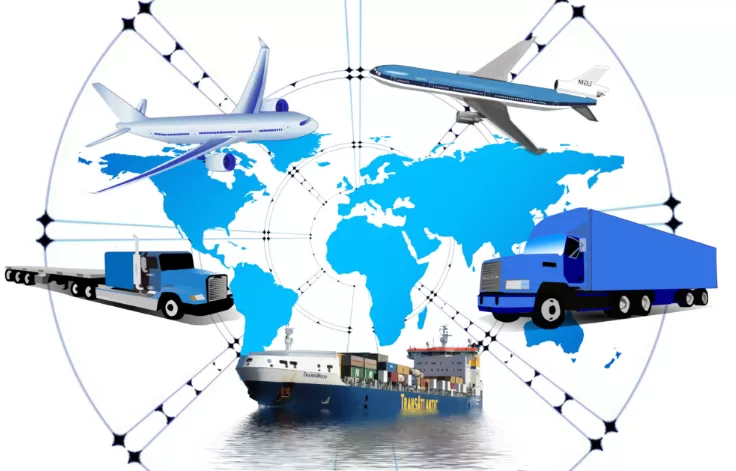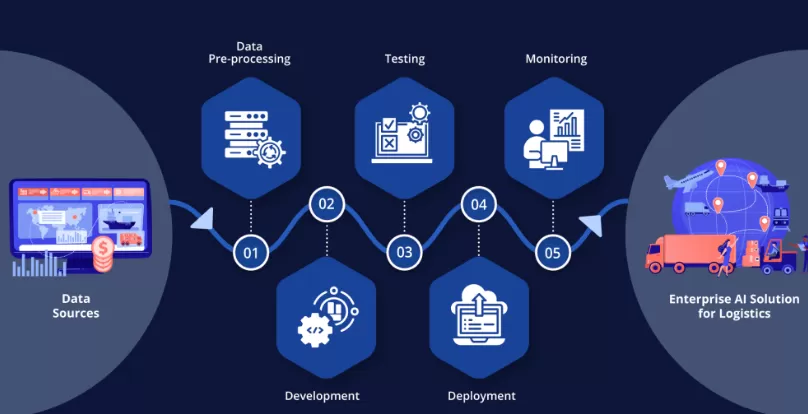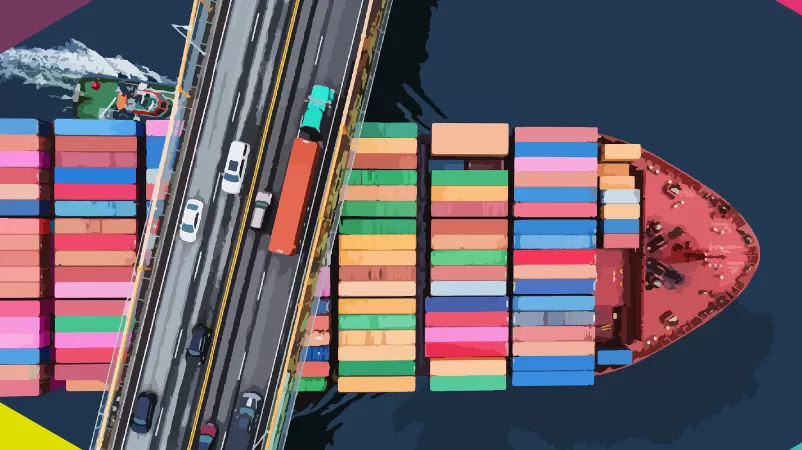If you're in international trade, you've heard the term "1PL, 2PL, 3PL, 4PL & Beyond." But if you think it's just a fancy word for shipping, you're missing the bigger picture—and it's probably costing your business time and money.
In today's global supply chain, logistics is your strategic advantage. It's the intricate engine that manages the flow of goods from your supplier’s door to your customer’s, navigating a complex web of transport, regulations, and time constraints. A deep understanding of logistics services is what separates thriving global businesses from those that struggle with delays, unexpected costs, and compliance headaches.
This guide goes beyond a simple definition. We will dissect the core components of logistics, provide a data-driven comparison of transport modes, and unveil the critical factors that impact your bottom line. Consider this your manual for mastering your supply chain.
Part 1: What Are Logistics Services? The Engine of Global Trade
At its core, logistics services encompass the end-to-end management of how resources are acquired, stored, and transported to their final destination. The ultimate goal is to deliver the right product, in the right quantity, in the right condition, at the right place, at the right time, and for the right cost.
Think of it as a symphony. Transportation is the most visible section, like the strings. But without the supporting sections of warehousing (percussion), inventory management (woodwinds), and customs compliance (brass), the result is chaos. A professional logistics provider acts as the conductor, ensuring every element works in harmony.
For an importer, this doesn't start when the container is loaded onto a ship. It starts the moment you place a purchase order, involving planning, packaging, documentation, and insurance. This holistic view is what defines modern, effective logistics.
Part 2: The Core Components of a Powerful Logistics Solution
A true logistics partner offers more than just a freight quote. They provide an integrated solution built on several pillars.
Transportation Management: The Backbone of Movement
This is the physical movement of goods. The expertise lies not in booking space, but in selecting the optimal mode and route based on your cargo's urgency, size, cost sensitivity, and nature. This includes multi-modal solutions, like combining trucking for inland movement with sea freight for the long haul.
Warehousing is no longer just storage. It’s a dynamic activity hub. Modern services include:
Cross-Docking: Unloading goods from an incoming container and immediately loading them onto outbound trucks, minimizing storage time.
Pick and Pack: Assembling individual orders for direct-to-consumer fulfillment.
Inventory Management: Real-time visibility of stock levels, preventing both stockouts and excessive capital tied up in inventory.
This is where many businesses face unexpected delays and fines. Compliance is non-negotiable. Expert logistics providers:
Ensure accurate HS code classification to avoid penalties.
Prepare and submit all required documentation (commercial invoice, packing list, certificate of origin, etc.).
Stay updated on constantly changing trade agreements and tariffs, potentially saving you thousands.
Gone are the days of "black box" shipping. Advanced cargo tracking systems provide real-time GPS location, container status (e.g., "Vessel Departure," "Customs Hold"), and predictive Estimated Time of Arrival (ETA). This transparency allows for proactive management of your inventory and sales planning.
Value-Added Services: The Competitive Edge
These are the services that tailor the logistics process to your specific needs:
Freight Insurance: Protecting your cargo's financial value against loss or damage during transit. This is a critical risk management tool often overlooked until it's too late.
Cargo Consolidation: Combining smaller shipments (LCL - Less than Container Load) into one full container, dramatically reducing costs for SMEs.
Packaging & Labeling: Ensuring your goods are packed to survive the international journey and labeled correctly for destination country regulations.
Part 3: Comparing International Transport Modes: A Data-Driven Decision
Choosing between sea, air, and rail is the most significant decision impacting your cost and transit time. Here’s a detailed breakdown.
|
Feature
|
Sea Freight
|
Air Freight
|
Rail Freight (e.g., China-Europe)
|
|
Best For
|
High-volume, non-perishable, cost-sensitive goods (e.g., furniture, raw materials).
|
Time-sensitive, high-value, or perishable goods (e.g., electronics, pharmaceuticals, fashion).
|
A balance between cost and speed for inland routes.
|
|
Cost
|
Lowest cost per kg/m³. Most economical for large volumes.
|
Highest cost. Premium for speed and security.
|
~30-50% cheaper than air, but more expensive than sea.
|
|
Transit Time
|
Slowest. e.g., China to EU: 35-45 days (including port delays).
|
Fastest. e.g., China to EU: 3-7 days door-to-door.
|
Intermediate. e.g., China to EU: 18-25 days.
|
|
Reliability
|
Subject to weather, port congestion, and schedule changes. Lower reliability.
|
Highly reliable and predictable schedules.
|
Generally reliable, but can be subject to border crossing delays.
|
|
Carbon Footprint
|
Highest absolute emissions, but lowest per kg/km.
|
Highest emissions per kg/km.
|
A more environmentally friendly option than air freight.
|
The Unique Advantage of Rail: The China-Europe rail corridor offers a strategic middle ground. It's not just about cost; it's about predictability. While slower than air, it's far more predictable than sea freight, which is vulnerable to issues like port strikes or the congestion seen in recent years. For businesses looking to de-risk from ocean volatility without paying air freight premiums, rail is an increasingly intelligent choice.
Part 4: The Hidden Factors That Make or Break Your Shipment
Quotes are based on assumptions. Real-world costs and timelines are determined by these critical details.
A Deep Dive into Cost Variables
Your freight quote isn't just a simple price. It's an aggregate of:
Ocean Freight/Air Freight Rate: The base cost with the carrier.
Fuel Surcharges (BAF for sea): Fluctuates with oil prices.
Currency Adjustment Factors (CAF): Adjustments for currency exchange risks.
Terminal Handling Charges (THC): Fees for loading/unloading at ports.
Incoterms 2020:This is crucial. Who is responsible for costs and risks at each stage? If you’re on EXW (Ex-Works), you bear all costs and complexity from the factory forward. A US FBA Tax-Inclusive vs Tax-Free arrangement means your provider handles everything. Misunderstanding Incoterms is a primary cause of unexpected costs.
The Real Meaning of "Transit Time"
Always distinguish between:
Port-to-Port: Time from departure port to arrival port.
Door-to-Door: The total time from your supplier's warehouse to your destination. This is the number that matters for your inventory planning. Door-to-door includes trucking, customs clearance, and potential warehouse dwell times.
Navigating the Maze of Regulations
Regulations are a moving target. Beyond standard customs, you must consider:
Sanitary and Phytosanitary (SPS) Measures: For food, plants, and animal products.
Product-Specific Regulations: Such as CE marks for Europe or FCC standards for the USA.
Restricted Party Screening: Ensuring you are not dealing with sanctioned entities.
A professional logistics partner acts as your compliance department, navigating these complexities on your behalf.
Choosing a provider based solely on the lowest price is the biggest mistake an importer/exporter can make. The cheapest option often becomes the most expensive when delays, fines, and damaged goods are accounted for.
You need a partner, not just a vendor. Look for:
Industry Specialization: Do they have experience with your specific product type (e.g., hazardous materials, temperature-controlled goods)?
Geographical Network: Do they have strong, owned offices or vetted partners in your key origin and destination countries?
Technology Platform: Is their cargo tracking system modern, intuitive, and provides proactive alerts?
Communication & Customer Service: Are they responsive and proactive? Can you speak to a dedicated representative who understands your business?
Financial Stability: A partner with strong finances is less likely to be disrupted by market volatility.
Conclusion: Your Logistics Strategy is Your Competitive Advantage
Logistics services are the circulatory system of your international business. A deep, strategic approach to managing them is no longer a operational task—it's a core business function that directly impacts profitability, customer satisfaction, and market agility.
It’s about making informed choices: balancing cost and speed with reliability and risk management. The right logistics partner provides the expertise and technology to turn your supply chain from a cost center into a powerful competitive weapon.
FAQ
1. Q: Is a logistics company the same as a freight forwarder?
A: Not exactly. A How to Pick a Freight Forwarder for Amazon FBA specialises in arranging the transport itself—booking cargo space, preparing documents—acting as a coordinator. A logistics company offers a broader scope; it typically includes freight forwarding but extends into integrated management of the entire supply chain, like warehousing, inventory control, and order fulfilment. Think of logistics as the umbrella that covers freight forwarding.
2. Q: My business is just starting, and my shipment volumes are small. Will a logistics provider even be interested in working with me?
A: Absolutely. Many providers specialise in serving small and medium-sized enterprises (SMEs). For smaller shipments, they can leverage LCL (Less than Container Load) services, consolidating your goods with other clients' cargo into a single container, which dramatically reduces your per-unit shipping costs.
3. Q: Beyond physical damage during transit, what unusual situations does freight insurance typically cover?
A: Standard marine insurance usually covers total loss (e.g., a container lost at sea), theft, and damage resulting from incidents like a carrier vehicle accident. You can also often purchase additional coverage for specific risks like war or strikes, depending on the trade route.
4. Q: How can a logistics provider support my company's sustainability goals?
A: They can assist in several key ways. This includes prioritising transport modes with lower carbon emissions (like rail over air), optimising routes to minimise empty miles, utilising eco-friendly packaging materials, and providing detailed carbon emission reports to help you measure and reduce your supply chain's environmental footprint.
5. Q: If my goods arrive damaged, what does the claims process look like?
A: Your first step is to photograph the damage and notify your provider immediately. They will then guide you through the required documentation and act on your behalf to file a claim against the actual carrier (the shipping or airline line). The entire process is governed by the paperwork you sign upon receipt and your insurance policy; a professional partner manages this efficiently for you.
6. Q: What's the real difference between 'Door-to-Door' and 'Port-to-Port' service, and how do I choose?
A: 'Port-to-Port' covers the movement from the origin port to the destination port only. You are responsible for customs clearance and final trucking. 'Door-to-Door' is a comprehensive service that includes collection from your supplier's warehouse right through to delivery at your designated address. For importers lacking experience in overseas clearance, 'Door-to-Door' is the far simpler and safer option.
7. Q: Can a logistics provider advise me on optimising my packaging to save money?
A: Yes, this is a key area where they add value. Based on the transport mode and your product's nature, they can suggest optimisations—like recommending lighter but durable materials to reduce volumetric weight (crucial for air freight) or designing more efficient packing patterns to maximise container space (for sea freight), directly cutting your freight costs.
8. Q: How much control and flexibility do I have once my shipment is en route? For instance, can I change the destination mid-transit?
A: It is possible, but it's complex and incurs significant extra charges. Changing the destination (known as a 'diversion' or 're-consignment') after departure requires carrier approval and involves amending documents, altering routing, and paying additional fees. The earlier the change is made, the lower the cost. Your provider can handle this, but it's always best to finalise the destination before shipment.
9. Q: For high-value or sensitive items (like art, precision instruments), what specialised logistics options exist?
A: Specialist providers offer 'project logistics' or 'exhibition logistics' solutions. These can include using dedicated vehicles with GPS tracking and tamper-proof seals, climate-controlled environments, trained security escorts, and arranging tailored, high-value insurance policies for complete peace of mind.
10. Q: How does a provider handle unforeseen delays, like a customs inspection?
A: A proactive provider is key. They work to ensure your documentation is perfectly compliant to minimise inspection risk. If an inspection does occur, they notify you at once and leverage their relationships and expertise at the customs house to facilitate a swift process, minimising the delay as much as possible.
11. Q: Can you help me manage multiple orders from different suppliers and consolidate them into one shipment?
A: This is called 'consolidation' or 'vendor management.' A provider can arrange a consolidation warehouse at the origin to receive goods from your various suppliers. Based on your schedule, they then merge these into a single, consolidated shipment. This not only saves on transport costs but also greatly simplifies your import paperwork and procedures.
12. Q: Beyond moving goods, can a logistics partner provide data analytics to support my business decisions?
A: Certainly. Advanced providers use their technology platforms to deliver analytics and reports on key metrics like transit time reliability, cost trends across different lanes, and warehouse turnover rates. These insights can help you optimise inventory levels, plan for sales campaigns, and better assess your overall supply chain performance.

 EN
EN
 FR
FR
 ES
ES
 JA
JA
 PT
PT
 RU
RU
 AR
AR








